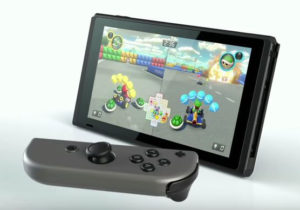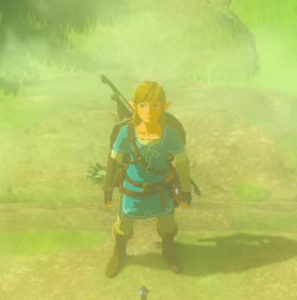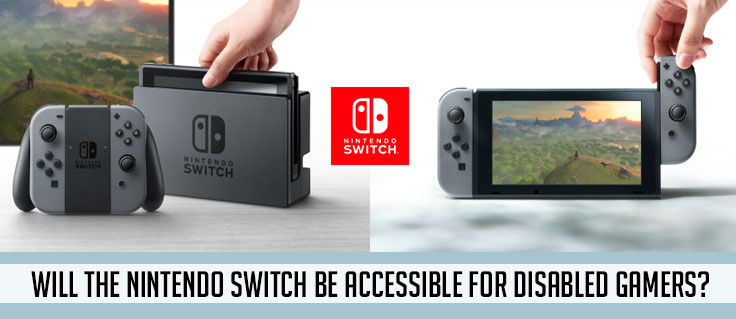I have fond memories of playing Mario Bros, Zelda, and Pokémon on a plethora of Nintendo consoles. The last time I picked up a Nintendo title was when Ocarina of Time came out; since then, the system became increasingly inaccessible, especially with the Wii. I felt like the company focused on getting people to move around, leaving many disabled people to look elsewhere for their entertainment. Motion-sensing games are not feasible for someone who can’t move their arms or hold up a bulky controller. The size of the N64 was cumbersome too, but my disability wasn’t as progressed at that time to render it completely inaccessible. Earlier systems, like the original Nintendo and the SNES, had smaller, lighter controllers with fewer buttons, but console designers moved away from that user experience.
When I heard about the Nintendo Switch, I assumed it wouldn’t be for me – and I wasn’t entirely wrong in that take. There are still going to be titles on the Switch I can’t play, namely ones that pull from the Wii system. For example, on launch day, they’ve announced 1-2 Switch, a series of mini-games utilizing the motion sensors. There’s also a game called ARMS (so original), where you use the controllers as boxing gloves. I think Nintendo will push hard on these styles of games, as VR and physical immersion are trending now.
But the Nintendo Switch introduces a customizable setup – and that could be the key to unlocking accessibility for some popular franchise games.
The Switch comes with Joy-Cons, two small controllers that you attach to the console in various ways depending on where and how you want to play. There is a docking station you can plug into the TV for gaming on the big screen. Pull the 6.4” tablet out from the dock to go portable, attaching the Joy-Cons on either side. The other option, which will probably work best for me, is detaching the controllers, putting the tablet up on its kickstand, and using one Joy-Con as the control.
 In researching for this post, I e-mailed Nintendo’s accessibility department and asked about the features for the Switch. They replied with a form letter, stating they don’t have any more information before the launch. I wonder if Nintendo considered accessibility in the design, or if disability access will once again be an afterthought. I’ve seen folks play the Switch at game cons, and the big-name websites tested it out – so why the secrecy on access now? Undoubtedly, questions are pouring in about the system, but I was hoping for some concrete info on accessibility.
In researching for this post, I e-mailed Nintendo’s accessibility department and asked about the features for the Switch. They replied with a form letter, stating they don’t have any more information before the launch. I wonder if Nintendo considered accessibility in the design, or if disability access will once again be an afterthought. I’ve seen folks play the Switch at game cons, and the big-name websites tested it out – so why the secrecy on access now? Undoubtedly, questions are pouring in about the system, but I was hoping for some concrete info on accessibility.
I haven’t gotten my hands on a Switch yet, so there’s no way to ensure I can play. If the Joy-Cons are small enough, and if the games have remappable keys, that would work for me. With the PS4, my problem with the controller is its size and weight combined with awkward button placements. Even if I can’t play all the Switch titles, there should be enough there in other games for me to stick with the console. The games I’m most excited about, Legend of Zelda: Breath of the Wild and Super Mario Odyssey, shouldn’t employ motion controls – fingers crossed.
My friend April, a fellow disabled gamer and founder of Ability Powered, shares her thoughts on the console: “I’m excited about the Nintendo Switch because of the controllers’ modular design. With a little velcro and button remapping, I can dive into the Nintendo library and catch up on years of game franchises. I am also scared to get my hopes too high because of Nintendo’s past accessibility and their love of controller movement.” Yeah, that sums it up for me – cautious excitement.
 Another concern is the price tag. The console with the tablet, docking station, and two controls is $300. Each game is $60, which is on par with other video games – but it still is a lot for a portable device. While the Switch may be more accessible in the physical mechanics, it remains an access barrier with how much it costs. As with much adaptable tech, it’s not accessible if you are priced out of it; this is something all designers, publishers, and other creators should keep in mind. We need community centers, open gaming venues, and other services for folks who want to play but don’t have disposable income to do so. I wish we lived in a Star Trek world where money no longer exists, but this is our reality now, and unfortunately, we need to look at cost when we talk or write about accessibility.
Another concern is the price tag. The console with the tablet, docking station, and two controls is $300. Each game is $60, which is on par with other video games – but it still is a lot for a portable device. While the Switch may be more accessible in the physical mechanics, it remains an access barrier with how much it costs. As with much adaptable tech, it’s not accessible if you are priced out of it; this is something all designers, publishers, and other creators should keep in mind. We need community centers, open gaming venues, and other services for folks who want to play but don’t have disposable income to do so. I wish we lived in a Star Trek world where money no longer exists, but this is our reality now, and unfortunately, we need to look at cost when we talk or write about accessibility.
Overall, I am keeping tabs on the Switch, and will wait until after the launch to see if it’ll be accessible for me; expect a review blog post when the time comes. Until then, I’ll watch the Zelda gameplay video on repeat.
What are your thoughts? Share in the comments below, or send a tweet to @geekygimp!


I am waiting for the release as crazy!
As a fellow disabled gamer & blogger, I would love to hear your comments about Nintendo’s apparent lack of remapping options on the Switch, now that it’s out. Particularly, I’m not sure if you’ve seen this piece about one disabled gamer’s experience:
https://waypoint.vice.com/en_us/article/nintendo-is-failing-its-disabled-fans
I actually wrote about it in my latest blog post 🙂 You can read my thoughts here: https://geekygimp.com/making-nintendos-switch-accessible-through-3d-printing/
I actually saw that AFTER I commented. Very good read!